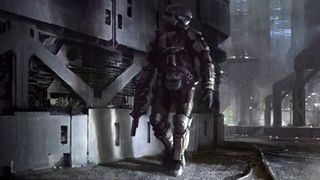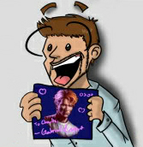The Top 7... things ODST does better than Halo 3
Lessons Master Chief should learn from his new little brother

Above: Who do you want to play?
What Halo 3 does: Nothing wrong. Nothing special, either. The Chief’s voice is iconic, of course, but you don’t hear it that often. If you did, would radio DJ Steve Downes (above, bottom right) have the talent to add layers, emotion and dimension? Cortana and the Arbiter are memorable, too, thanks to reliable work from hard-working but mostly unknownindustry stalwarts like Jen Taylor and Keith David. Everyone else? We can barely remember…
What ODST does: Heads to Hollywood for proven geek star power. Firefly’s Nathan Fillion (Captain Tight Pants, above top right) and Battlestar Galactica’s Tricia Helfer (Number Six, above left) both appear in major roles. Yes, casting known actors in a videogame can backfire –here’s all the proof you need– but they’re usually famous for good reason, and if chosen correctly, can bring extra experience to the character. Extra impact, too… there’s no substitute for the “Wait, is that?” tingle you receive with a recognized voice.
ATMOSPHERE

What Halo 3 does: Hey, you’re on a big, bright spaceship! Now you’re on a big, bright space station! And what’s this? A deadly metal ring that is also big, bright and in space? Don’t worry, you can go to the beach, the desert and the jungle, too! Just don’t expect mist at the beach, dust in the desert or shadows through the jungle. They’re also big, bright and… well, you know the rest.
What ODST does: Adds texture, mood and even a touch of realism. The entire game takes place in New Mombasa, a slightly (not wildly) futuristic city in Africa. Yes, on Earth. You’ll wander urban streets, battle across office rooftops and dogfight through skyscrapers. No Arks, Installations, Delta Halos or Forerunner Citadels in sight. More crucial, though, are the atmospheric touches like rainfall, darkness and fog, as well as tinier details like abandoned corpses (“Who killed all these Brutes?”), softly glowing billboards (“Destiny Awaits”) and rebellious graffiti (“Glass this!”).
MUSIC
What Halo 3 does: The most rousing and recognizable videogame score of the past decade. You can’t listen to Halo’s theme and not want to rush home immediately to play. So what’s the problem? Like the music for Star Wars or Star Trek, we’re starting to take the thing for granted. The more it’s repeated – whether in the game or in the endless fan tributes – the less power it holds over us. Eventually, that theme runs the risk of becoming annoying, a commercial jingle stuck in our heads that we both love and resent.
Sign up to the GamesRadar+ Newsletter
Weekly digests, tales from the communities you love, and more
What ODST does: Mixes the score up, surprising the jaded listener with unexpected instruments and softer melodies. When you’re at the height of action, the music is still as epic as ever; sometimes, you’ll even hear hints of the most climactic moments in the original Halo. But when you’re playing as The Rookie, all alone in the dark streets of Mombasa and trying to piece together what happened to the rest of your team, the sounds shift dramatically. Smoky saxophone solos replace blazing guitar riffs, and lingering silences create a noir detective mood. When the bombastic music returns, you’ll appreciate it a lot more.

"This cannot be tolerated": Escape from Tarkov community in meltdown over $250 edition with exclusive PvE mode, as a 131-word chant consumes the official Discord

Arrowhead gives Helldivers 2 players hope for fiddly auto-climb feature and says it's "possibly tweaking" how it works "in the near future"

BlizzCon is canceled again, and Blizzard hasn't really explained why - but says it's coming back "in future years"
Most Popular




